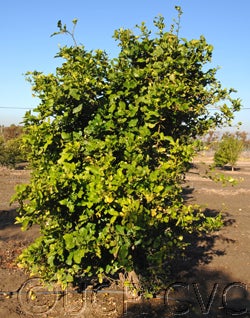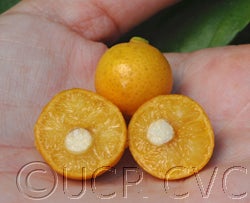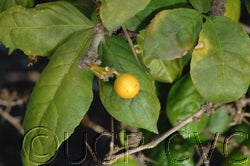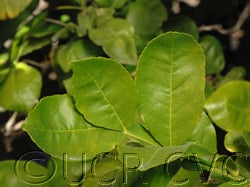Uganda cherry-orange
CRC 3126
PI 231240
Source
Received as seed from H. Chapot, Rabat, Morocco, 1956.
Parentage/origins
Parents unknown
Rootstocks of accession
Carrizo citrange, C-35 citrange
Season of ripeness at Riverside
August to December
Seasons of flowering at Riverside
March to August
Notes and observations
EMN, 12/22/1987: Has not done well, tree 10 is very poor. Probably this cultivar is not well adapted to the Riverside environment. No fruit yet.
EMN, 2/22/1988: Dr. Bitters thinks this is C. gilletiana, not C. schwein… and that this and CRC 3296 are the same. Trees are poor in the field so a good comparison is not available at this time.
EMN, 4/7/1988: This accession compared with CRC 3296, Citropsis gilletiana, at South Coast Field Station. These two are similar but not totally identical. Tim Williams thinks both are C. gilletiana but are different varieties. We probably don't have true C. schweinfurthii.
EMN, 1/20/1989: Only 1 green fruit found- very much like fruit of CRC 3296.
Description from The Citrus Industry Vol. 1 (1967)
"Small tree, ultimate branches at first angled, soon terete, often with single or paired spines 1-2.5 cm long; leaves medium-sized, 3-5-foliolate, 12-30 X 12-20 cm, leaflets oblong or lanceolate, tapering rather abruptly to a short, blunt acumen, cuneate at base, margins denticulate to subentire, terminal leaflets usually narrowly cuneate at base, 10-15.5 X 3-5.5 cm, lateral leaflets more broadly cuneate at base, 8-14 X 3.5-5.5 cm, petioles broadly winged but usually slowly narrowed and rounded at both ends, 5.5-10 X 2-3 cm, rachis segment similar in shape to petioles but shorter and narrower, 4-9 X 1.5-2.8 cm; inflorescences axillary, short (1-2 cm), many flowered, pedicels 2 mm long, 1 mm wide at base, gradually thicker upward and about 2 mm wide at base of calyx, flowers white, fragrant, usually 4-merous, about 2.2-2.5 cm when fully expanded, calyx with 4 thick, short, blunt lobes, petals 4, 12-15 X 4-5 mm, broadly rounded at tips, stamens 8, 10-11 mm long, flattened and broad 3/4 of way to top, 0.5 mm thick, 1.4-1.6 mm broad; disk 1 mm high, 3 mm broad, surrounding narrowed base of ovary with a shallow (0.3-0.4 mm), thick-walled cup with small scattered oil glands on inside near base, pistil 10-11 mm long (including disk), ovary ovate, 4-locular, 2 mm high, 2.5 mm wide, rounded at tip with style often (always ?) attached to one side of center of tip!, style short, stout, 6-7 X 1.1-1.4 mm, expanded slightly at tip, stigma cushion-shaped, 0.9-1.1 mm high, 2-2.5 mm wide, 4-lobed at tip, with very small oil glands between stylar canals; fruits subglobose, lemon-yellow when ripe, fragrant, 2-2.2 cm diam., locules filled with numerous, sessile pulp-vesicles that occupy all free space, seeds slightly roughened, 9-12 X 7-8 mm, monoembryonic.
Citropsis schweinfurthii was grown for many years in the United States and thrived in the Washington greenhouses of the U.S. Department of Agriculture, where it flowered profusely and set fruit freely while still a small tree. The leaflets are narrower than those of most of the other species except the related C. angolensis of Angola and the very different C. daweana of Mozambique. The leaflets of the Uganda cherry-orange show 6 to 8 lateral veins, slightly elevated below and slightly depressed above. The surface of the leaflets is nearly plane. The fruits of C. schweinfurthii are often borne in clusters of two to five on short axillary inflorescences; they are almost spherical or very slightly flattened at the top and 22 to 25 mm in diameter. The peel is very thin, 1 to 1.5 mm thick. The ripe fruit ranges in color from Empire yellow to Apricot yellow (Ridgway, 1912, pl. 4). The pulp, when seen in cross section, is straw yellow, amber yellow, or even mustard yellow (Ridgway, 1912, pl. 16) near the peel. The pulp-vesicles fill all the space in the cells of the ovary not occupied by the plump seeds, of which 1 to 4 may develop, never more than one in each locule. The pulp-vesicles contain in their center a long column of oil droplets, irregular in diameter and not sharply delimited. The oil droplets are extremely variable in size, though most of them are small. The mawkish taste of the pulp is doubtless due to these droplets of oil.
The Uganda cherry-orange can be grafted readily on Citrus (Swingle and M. Kellerman, 1914, p. 435, pl. 49). It can also be made to grow, but less vigorously, when grafted on the wood apple, Feronia limonia, or on the Philippine tabog, Swinglea glutinosa. It is well worth growing as an ornamental in the greenhouse, as it not only has handsome foliage, but also bears, for months at a time, a great profusion of white bloom looking much like orange flowers, with a strong but agreeable odor about midway between that of citrus flowers and that of the North American wild plums (Prunus americana and other species)."
Availability
Not commercially available in California.
USDA Germplasm Resources Information Network page for Citropsis schweinfurthii



